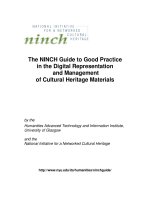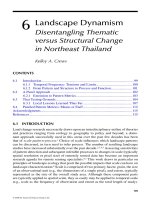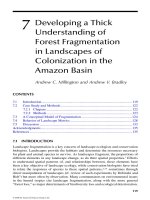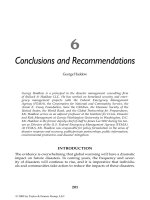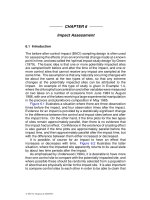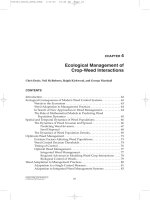NATURAL ARSENIC IN GROUNDWATER: OCCURRENCE, REMEDIATION AND MANAGEMENT - CHAPTER 18 pdf
Bạn đang xem bản rút gọn của tài liệu. Xem và tải ngay bản đầy đủ của tài liệu tại đây (370.49 KB, 8 trang )
155
Natural Arsenic in Groundwater: Occurrence, Remediation and Management –
Bundschuh, Bhattacharya and Chandrasekharam (eds)
© 2005, Taylor & Francis Group, London, ISBN 04 1536 700 X
Geochemistry and geomicrobiology of arsenic in Holocene
alluvial aquifers, USA
J.A. Saunders, M.K. Lee & S. Mohammad
Department of Geology and Geography, Auburn University, Auburn, USA
ABSTRACT: Groundwaters in Holocene alluvial aquifers in the USA contain elevated dis-
solved arsenic (As) have similar geochemical characteristics and microbiology. These include:
(1) near-neutral pH and moderately reducing redox state; (2) significant dissolved iron and man-
ganese; (3) presence of both iron- and sulfate-reducing bacteria; and (4) evidence that precipitation
of authigenic carbonates and sulfides limits metal (loid) solubility. Our research indicates that
anaerobic bacteria directly mediate dissolution of iron and manganese minerals in the alluvial
aquifers leading to release of As and other trace elements, and also indirectly cause the precipita-
tion of authigenic minerals such as siderite and rhodochrosite. Genetic sequencing indicated that the
genus Geobacter are responsible for As release from Fe-oxyhydroxide. We propose a global-scale
Geo-Bio-Hydro (GBH) arsenic cycle that directly invokes Pleistocene glaciers as important in physic-
ally weathering rocks setting the stage for Holocene chemical weathering that initiated a major
release of As to the hydrosphere.
1 INTRODUCTION
There is now a general consensus that bacterial dissolution of arsenic-bearing iron oxyhydroxides
(also known as hydrous ferric oxides, HFO) is the principal mechanism leading to As release in
groundwaters hosted by Holocene river flood-plain deposits in such places as Bangladesh, India,
Hungary, etc. (e.g. Chatterjee et al. 1995, Bhattacharya et al. 1997, Nickson et al. 1998, Acharrya
et al, 2000, Nickson et al. 2000, Welch et al. 2000, McArthur et al. 2001, Smedley & Kinniburgh
2002, Dowling et al. 2002, Anawar et al. 2003, van Geen et al. 2003, Ahmed et al. 2004, Akai et al.
2004, Zheng et al. 2004). Further it is clear that this process occurs under moderately reducing
redox conditions caused by the presence of aqueous or solid organic matter in the sediments
(Nickson et al. 2000, McArthur et al. 2001). We (Saunders et al. 2003, Mohammad 2003) have
proposed that the geochemical and microbiologic conditions leading to As-contamination of
Holocene alluvial aquifers is universal in flood plains where river or stream sediments are deposited
with organic matter. In this paper, we review our research findings from two field areas in the USA
which appear to be in every way analogous to the problematic areas of the world adversely impact-
ing human health due to As contamination. Further we show that one common type of iron reduc-
ing bacteria (FeRB) causes the As problem at of our USA field sites, where we have identified the
“guilty” bacteria (present only in groundwaters with more than 50 g/L As) using DNA sequenc-
ing techniques. Moreover, we propose this bacterium is likely responsible for the As problem else-
where in the world, although clearly confirmation outside of USA is necessary and is planned.
2 GEOLOGY, GEOCHEMISTRY, AND GEOMICROBIOLOGY OF USA FIELD AREAS
Korte (1991) was first to document natural As contamination at an alluvial floodplain in the USA, and
we chose his “discovery” area at the U.S. Department of Energy’s (DOE) Kansas City Plant (KCP)
Copyright © 2005 Taylor & Francis Group plc, London, UK
to conduct our research. The KCP study area is located in floodplain deposits of the Blue River, a
tributary of the Missouri River (Mohammad, 2003). The aquifer at the KCP site consists mainly of
stream-valley alluvial deposits composed of Holocene alluvium which unconformably overlie
Pennsylvanian strata of limestone and shale. Alluvial deposits typically consist of sand and gravel
deposits of locally intermittent lenses of sand, silt, and clay. Groundwater at the KCP site is uncon-
fined but locally can exist under confined conditions where clay layers are present (Mohammad
2003, Saunders et al. 1997). Water levels in wells at the KCP typically are Ͻ7m. Our second study
area is located along Uphapee and Choctafaula creeks in an extensive Holocene floodplain
deposits in central Alabama. These alluvial deposits have C-14 ages Ͻ7000 years old and consist
primarily of silty sand containing erratic but common macro wood fragments up 0.5 m in size. The
alluvium unconformably overlies the Cretaceous Tuscaloosa Group of the Alabama Coastal Plain
in the study area. Groundwater is unconfined with depths to the water table typically Ͻ2m.
Groundwater at the Kansas City Plant is highly variable in redox state, iron (and manganese)
content, and has near-neutral pH conditions. Arsenic was significantly elevated (e.g., Ͼ50 g/L in
three of the eight monitoring wells, which also happened to have the lowest Eh values (Mohammad
2003). Dissolved Fe ranged from 0.2 to 17.1 mg/L, Mn from 0.5 to 7.9 mg/L, and alkalinity rang-
ing from 175 to 350 mg/L (as CaCO
3
). Groundwater chemistry for the Alabama field site is gen-
erally similar to that of the KC site. It contains elevated Fe and Mn (up to 1 and 3 mg/L respectively,
consistent with its moderately reducing nature), pH 6.6 to 6.8, 1–10g/L each of As, Co, Ni, Zn,
REEs, and 50–175 g/L of Ba. Further, sulfate reducing bacteria (SRB) in this alluvial aquifer use
detrital wood fragments as the ultimate electron donor which leads to precipitation of pyrite cont-
aining up to 0.62 wt.% As and commonly, pyritization of the wood (Saunders et al. 1997).
Several researchers have proposed that Fe- and possibly Mn-reducing bacteria may have been
important in producing As-contaminated groundwater in Holocene alluvial aquifers. However,
this has only been inferred from the high Fe (and Mn) contents of groundwaters with elevated As,
its moderately reducing state, and a general correlation between dissolved Fe, As, and alkalinity
(e.g., Nickson et al. 2000, McArthur et al. 2001, Ahmed et al. 2004). To evaluate this hypothesis,
we conducted reconnaissance microbiologic investigations at our two field sites. At the Kansas
City site, we collected two different types of samples for microbiologic investigations: groundwa-
ter for culturing of viable bacteria; and (2) bacteria filtered from several liters of groundwater in the
field for molecular microbiology studies. Only wells at the Kansas City site that had elevated iron,
Mn, and As could anaerobic bacteria be cultured, and both FeRB and SRB were found in these
water samples. These groundwaters also had the lowest field Eh values. The microbiologic data
suggest that FeRB are present and available to catalyze Fe-reduction in the As-enriched wells and
thus this is the first direct indication from the field of their involvement in producing arsenic cont-
amination in groundwater.
Similar to the culturing experiments from the KCP site, cloning and sequencing of the 16S rDNA
genes extracted from bacteria filtered from groundwater also indicated the presence of FeRB and
SRB from the As-rich samples. Clones with sequences similar to known FeRB (e.g., Geobacter
sp.) were also abundant in the As-rich water samples. Thus the molecular biological data corrob-
orates the bacterial culturing results. In contrast to the Kansas City site, we used a truck-mounted
auger to advance a borehole into the alluvial aquifer at the Alabama field site and collected solid
samples below the water table for microbiologic and chemical analyses. Both FeRB and SRB were
cultured from the aquifer, and enumeration using the most probable number (MPN) method indi-
cated that FeRB were most abundant.
3 GEOCHEMICAL MODELING: IMPLICATIONS FOR ARSENIC MOBILITY
Geochemical modeling with PHREEQC (Parkhurst 1999) indicates that groundwater samples
have positive saturation indices (SI) for siderite in two of the three As-elevated wells and super-
saturated SI values for rhodochrosite in all three elevated-As wells at the KCP site. Similarly, all
eight groundwater samples appear to be supersaturated with respect to goethite and understaurated
156
Copyright © 2005 Taylor & Francis Group plc, London, UK
with respect to ferrihydrite, suggesting that an iron oxyhydroxide phase with a solubility intermed-
iate between those two might have been the source of iron in groundwaters.
Additional geochemical modeling was conducted with the Geochemist’s Workbench (Bethke
1996) to compare groundwaters from the KCP study area to groundwaters from As-contaminated
areas of Bangladesh, using published data from the British Geological Survey’s (BGS) “Special
Study” where Eh was also measured in the field (British Geological Survey 2004). The BGS data
plot in the same general area in Eh-pH space (Fig. 1) with a shift perhaps to slightly higher Eh val-
ues when the much larger data set is plotted. Similarly, Eh-pH plots were made for average geo-
chemical conditions (with respect to Fe, Mn, carbonate, and S species) for both the KCP site
groundwaters and those from Bangladesh (Fig. 1). KCP groundwaters plot near the Fe
2ϩ
-siderite
and Mn
2ϩ
-rhodochrosite boundary suggesting they are approaching local equilibrium with both
mineral phases (consistent with siderite SI values discussed previously). The most As-rich ground-
water samples from the KC study area plot close to the stability field of pyrite (Fig. 1). As before,
KCP and Bangladesh groundwaters plot in the same approximate areas in Eh-pH space. Similarly,
groundwaters from Bangladesh appear to be close to equilibrium (or are supersaturated with) with
respect to siderite and rhodochrosite. The Eh-pH values for the KCP waters indicate that they are
in the stability fields of both arsenate (As-V, HAsO
4
Ϫ
) and arsenite (As-III, As(OH)
3
o
or H
3
AsO
3
o
),
although the most As-enriched samples are in the arsenite stability field and even into the narrow
stability fields of solid mineral phases realgar (AsS) and orpiment (As
2
S
3
).
Results of our study support the general concept that As occurs in moderately reducing and typ-
ically Fe- and Mn-rich groundwaters. Anaerobic heterotrophic bacteria mediate the reductive diss-
olution of Fe and Mn minerals (and arsenic release) by the following chemical reaction:
(1)
where *As is sorbed As on iron oxyhydroxide and CH
2
O is generic organic carbon. Figure 1 shows
that Mn-reduction occurs under more oxidizing conditions, and Mn-reducing bacteria will out-
compete Fe-reducers as long as reactive solid Mn phases are available (Chapelle & Lovley, 1992).
The presence and abundance of FeRB such as Geobacter in our two study areas provide the first
157
Figure 1. Redox-pH diagram for arsenic drawn at 25°C and fixed As and H
2
S activities of 10
Ϫ 2
. Also shown
is the groundwater geochemistry data from Bangladesh (oval) and the Kansas City Plant (cross ϭ As Ͻ 10g/L;
circle ϭ 10–15 g/L; diamond ϭϾ50g/L).
Copyright © 2005 Taylor & Francis Group plc, London, UK
field evidence supporting the hypothesized bacterial reduction of iron oxyhydroxide and As
release to groundwater.
Moderately reducing, As-enriched groundwaters from the Kansas City site are generally super-
saturated with respect to rhodochrosite and siderite. Saunders & Swann (1992) proposed that
metabolism of Fe- and Mn-reducing bacteria could facilitate precipitation of both carbonate
phases in aquifers because the products of reaction 1 become the reactants for Fe- and Mn-carbonate
precipitation:
(2)
Mukherjee et al. (2001) and Pal et al. (2002) have observed authigenic siderite and rhodochrosite
in alluvial aquifers in India, and documented textures very similar to those from Saunders &
Swann (1992). Further, Saunders & Swann (1992) observed that authigenic carbonate phases
often had inclusions of sulfide minerals such as pyrite and proposed that biogenic sulfate reduc-
tion probably occurred at the site of carbonate deposition. Because biogenic sulfate reduction
raises pH and produces alkalinity as well as H
2
S (reaction 3a), this could explain both carbonate
precipitation and iron sulfide formation (e.g., reaction 3b):
(3a)
(3b)
Thus we propose that if Fe- and Mn-reducing bacteria are producing the moderately reducing,
metal- and As-rich waters observed in this study and elsewhere in river floodplain deposits, then
siderite and rhodochrosite are important phases controlling the solubility of iron and manganese
in these waters. Precipitation of siderite will preferentially remove Fe relative to As in groundwa-
ter (Dowling et al. 2002), which can explain the often-observed poor statistical correlation for Fe and
As in many similar groundwaters. By the same token, precipitation of iron sulfides could prefer-
entially remove As relative to iron (by coprecipitation) and also affect the remaining As/Fe ratios in
groundwater. Several researches have observed As-bearing pyrite as an authigenic phase in alluvial
aquifers, which has led some researchers to propose that it was the source of As in alluvial aquifer
groundwaters. This is highly unlikely due to the redox state of the water and the general lack of dis-
solved sulfate. We propose that SRB have removed limited sulfate in solution in these terrestrial
waters and removed a small amount of Fe and As in the process (e.g., reactions 3a and 3b along with
As coprecipitation in Fe-sulfide). Thus As-bearing pyrite is a sink for As rather than a source.
3 GEO-BIO-HYDRO (GBH) ARSENIC-CYCLING MODEL
We propose that a series of linked geochemical, biologic, and hydrologic processes operating over
geologic time scales can lead to natural As contamination in Holocene fluvial and fluvial-glacial
deposits around the world. We suspect that the conditions for this type of As contamination are
very common, but the situation becomes particularly problematic in developing nations where
existing surface water supplies are contaminated by parasites, fecal bacteria, etc. Further, our prop-
osed GBH-As process requires neither As-rich (above crustal abundances ϳ2 ppm) source rocks
nor rare or specialized microorganisms. The one “out-of-the-ordinary” aspect to the GBH process
is the recognition that recent Earth history of continental glaciation and retreat exacerbates the nat-
ural As contamination process. “Normal” chemical weathering of minerals in folded mountain
belts or other crustal rocks will release As to the hydrosphere and may even locally contaminate
groundwater supplies. However, we propose that continental and/or alpine glaciation during the
last ϳ5 million years lead to the present-day widespread occurrence of As in Holocene ground-
waters in river floodplains that are most problematic around the world. Although clearly not all As-
contaminated groundwaters have been impacted by chemical weathering of glacial deposits, the
158
Copyright © 2005 Taylor & Francis Group plc, London, UK
proximity of extensive As-contaminated groundwaters in Holocene river floodplains (e.g., in
Indian Sub-continent, China, North America, Hungary) adjacent to significant glacial deposits
“up-stream” argues for a genetic link in space and time. Low hydraulic gradients in the Holocene
river floodplains exacerbates the problem, as the As-contaminated waters are not rapidly flushed
out of these aquifers. Thus from the perspective of geologic time, the problem is ephemeral but
unfortunately coincides with recent human history.
The GBH process is initiated by continental glaciation and its associated physical weathering of
continental rocks in its path. Glaciation sets the stage for accelerated chemical weathering of the
reactive, high-surface-area minerals ground down by glaciers, which release As to the hydrosphere.
Ferromagnesian silicate minerals typically contain minor amounts of arsenic and other trace elem-
ents. For example, the common sheet silicate biotite has a crystal structure leading to very rapid
weathering (Saunders et al. 2000) and As release. Thus we propose that, Fe bearing silicates along
with As-bearing sulfide and clay minerals are likely the ultimate source of As to the GBH-As
process. Weathering of Fe bearing silicates and sulfides leads to the formation of iron oxyhydroxide,
which are then physically transported by running water initially to streams and then through meand-
ering stream channels. Some of the HFO would be colloidal in size and transported in suspension,
larger grains, including HFO-coated sand grains, reside in stream bed load. Both suspended and
bed-load HFO’s have a tremendous affinity to adsorb dissolved As. However, suspended HFO tend
to move at the same average velocity as the transporting stream flow, and thus have a short residence
time estimated to be ϳ2 weeks for major river systems discharging into oceans (Freeze & Cherry,
1979). On the other hand, HFO in river bed load has a much longer residence time and may become
the loci of iron precipitation by iron-oxidizing bacteria in streams (Saunders et al. 1997); such bio-
geochemical reactions effectively create new and reactive HFO surfaces. The residence times of river
bed-load sediment are difficult to quantify but small scale-studies suggest they may be in the order
of 0.1 to 1 year per km length of the river (Meade 1982, Kelsey et al. 1987, Olley et al. 1997). Thus
a major river system may have a water residence time of 2 weeks and a bed load residence time of
10
3
to 10
4
years. So using a residence time of 5 ϫ 10
3
years for a major river system, stream bed load
would have ϳ1.3 ϫ 10
5
river volumes flowing over and through it during its transport in the river,
and As is slowly adsorbed onto the HFO surfaces. We propose that the long-term adsorption is the
important As-concentration mechanism that ultimately leads to natural As contamination of ground-
water in the lower reaches of the river systems where extensive floodplains develop. In the flood-
plains, reactive organic matters co-deposited with As-bearing HFO’s causes anaerobic conditions
and FeRB metabolism. This portion of the GBH cycle is essentially the “HFO-As” hypothesis that
we and others have proposed previously. We propose that the HFO-As hypothesis is just a part of a
much bigger continent-scale process. Fluvial and fluvial-glacial deposits typically have low diss-
olved sulfate as opposed to river deltas where seawater sulfate can mix with fresh groundwater,
which has caused the formation “high sulfur” (and locally As?) Carboniferous coal deposits in the
eastern USA and elsewhere. Thus SRB cannot effectively remove a significant amount of As
released by FeRB bacteria in the anaerobic flood-plain groundwater. However SRB do cause some
local pyrite precipitation and As removal (Saunders et al. 1997, Nickson et al. 2000, McArthur et al.
2001); this has led to confusion about pyrite being a source of As in river flood-plain sediments.
Pyrite is really an As sink that also causes the observed inverse correlation between dissolved As and
sulfate seen in Bangladesh and our Kansas City study area. A major implication of the GBH-As
cycle is that it leads to a prediction of potential problem areas for natural As contamination as world
population increases and new water sources are required. Currently, because groundwater in Holocene
aquifers have elevated iron contents, it has led to the under usage of these groundwaters in the
developed nations, and many of these same groundwaters may also happen to have elevated As.
4 POSSIBILITY OF BIOREMDIATING ARSENIC USING SRB
We have successfully stimulated naturally occurring SRB to remediate metal-contaminated ground-
water at a number of sites (Saunders et al. 2001, Lee & Saunders 2003, Saunders et al. 2004). SRB
159
Copyright © 2005 Taylor & Francis Group plc, London, UK
metabolism causes certain toxic metals to precipitate out of groundwater as relatively insoluble
sulfide minerals (e.g., Zn, Pb, Cd, Ag, Cu, Hg, etc.), some redox-sensitive metals to precipitate as
oxy-hydroxide phases (e.g., Cr, U), and raises groundwater pH which can also lead to increased
sorption of some elements. However, raising pH can cause As to desorb. This, coupled with the
possibility of As-thio complexing (Wilkin et al. 2003), makes the geochemical behavior of As
under sulfate-reducing conditions not so straightforward even though it forms its own sulfide min-
erals and coprecipitates in Fe-S phases. However, our research suggests that these problems can be
overcome if a strategy of optimizing the geochemical conditions for removal of As from solution
is employed. It appears that high dissolved iron content favors arsenic coprecipitation in Fe-S sul-
fide phases under sulfate-reducing conditions, and limits the As-thio complexes (Wilkin et al.
2003). Thus, we propose that bioremediating As-contaminated groundwater is possible by adding
a solution of hydrous ferrous sulfate and a carbon electron donor (e.g., sucrose, molasses, methanol,
ethanol, etc.) through injection wells. The lack of ferrous iron can limit SRB metabolic efficiency
because Fe(II) is present in many of the enzymes and compounds used in electron transfers by
SRB. In the past, researchers have assumed that H
2
S was toxic to SRB, but actually the “toxicity”
effect of H
2
S is the removal of Fe(II) by Fe-S precipitation. Thus, injection of dissolved Fe(II) into
As-contaminated groundwater: (1) insures that iron will be available for SRB metabolism; (2) limits
the buildup of potentially toxic levels of H
2
S; (3) keeps the Fe(II)/H
2
S ratio high enough to keep
As-thio complexes from occurring to any significant extent, and (4) provides both the Fe and S
needed for the As-“encapsulating” FeS phases. Thus this approach can be effective in treating As-
contaminated groundwater as the conditions for As-coprecipitation in FeS are optimized.
4 CONCLUSIONS
Regulatory agencies around the world typically have a “secondary” drinking water standard (not
health-based) for iron of 0.5 mg/L, and thus Fe-rich groundwater in the United States and other
“developed” nations has largely been used for irrigation of crops and not for human consumption.
We believe the high iron content has led to the under-appreciation of the fact that elevated As is
common in alluvial aquifers in the developed nations of the world as well as countries such as a
Bangladesh, India, Pakistan, etc. The major difference is that rivers in the developed nations are
kept clean enough for drinking water purposes because of the investment in expensive infrastruct-
ure, and rivers in developing nations are commonly polluted and not fit for drinking. This has
driven the use of the iron- and locally As-rich groundwaters of Holocene river floodplains.
Previous studies have noted that groundwaters with elevated arsenic in alluvial floodplain deposits
also have elevated iron (typically 1–50mg/L). Other specific conclusions:
(1) We have identified Geobacter using DNA analysis (and FeRB by culturing) in groundwaters
with elevated Fe, Mn, and As in our USA field areas and we propose that this type of anaero-
bic FeRB bacteria cause the As problem in Holocene alluvial aquifers around the world, but
verification is needed.
(2) Authigenic carbonate and sulfide minerals appear to precipitate as a consequence of anaerobic
bacteria metabolism. These minerals will affect observed present-day groundwater As/Fe
ratios and metal solubility.
(3) Our GBH-As cycle proposes that Pleistocene glaciers played a major role in the weathering-
induced release of As to the hydrosphere in the Holocene, and that the As-concentrating mech-
anism is sorption by HFO in stream sediments which have much longer residence time than
river waters. The subsequent action of dissimilatory iron and sulfate anaerobic bacteria control
the fate of As and other redox-sensitive elements in Holocene alluvial aquifers.
(4) Bioremediation may be possible using SRB if the Fe/H
2
S ratio is kept elevated in As-bearing
groundwater to prevent the formation of soluble thio-arsenite species. However, this is not
likely a panacea for remediating natural As contamination in the Bengal Basin and similar
areas, but may prove useful for anthropogenic arsenic pollution.
160
Copyright © 2005 Taylor & Francis Group plc, London, UK
REFERENCES
Acharyya, S.K., Lahiri, S., Raymahashay, B.C. & Bhowmik, A. 2000. Arsenic toxicity of groundwater in parts
of the Bengal Basin in India and Bangladesh; the role of Quaternary stratigraphy and Holocene sea-level
fluctuation. Environ. Geol. 39: 1127–1137.
Ahmed, K.M., Bhattacharya, P., Hasan, M.A., Akhter, S.H., Alam, S.M.M., Bhuyian, M.A.H., Imam, M.B.,
Khan, A.A. & Sracek, O. 2004. Arsenic enrichment in groundwater of the alluvial aquifers in Bangladesh:
An overview. Appl. Geochem. 19: 181–200.
Akai, J., Izumi, K., Fukuhara, H., Masuda, H., Nakano, S., Yoshimura, T., Ohfuji, H., Anawar, H.M. & Akai, K.
2004. Mineralogic and geomicrobiologic investigations on groundwater arsenic enrichment in Bangladesh.
Appl. Geochem. 19: 215–230.
Anawar, H.M., Akai, J., Komaki, K., Terao, H., Yoshioka, T., Ishizuka, T., Safiullah, S. & Kato, K. 2003.
Geochemical occurrence of arsenic in groundwater of Bangladesh; sources and mobilization processes.
J. Geochem. Explor. 77: 109–131.
Bhattacharya, P., Chatterjee, D. & Jacks, G. 1997. Occurrence of arsenic-contaminated groundwater in alluvial
aquifers from Delta Plain, Eastern India: options for safe drinking water supply. Wat. Res. Dev. 13: 79–92.
Bethke, C.M. 1996. Geochemical Reaction Modeling. New York, Oxford University Press.
British Geological Survey 2004. The groundwater arsenic problems in Bangladesh (phase 2), website:
www.bgs.ac.uk/arsenic/bangladesh/Data/SpecialStudyData/csv.
Chapelle, F.H. & Lovely, D.R. 1992. Competitive exclusion of sulfate reduction by Fe (III)-reducing bacteria.
Ground Water 30: 29–36.
Chatterjee, A., Dipankar Das, Mandal, B.K., Chowdhury, T.R., Samanta, G. & Chakraborti, D. 1995. Arsenic
in Ground Water in Six Districts of West Bengal, India. The Biggest Arsenic Calamity in the World. Part 1.
Arsenic Species in drinking water and urine of the affected people. The Analyst 120: 643–650.
Dowling, C.B., Poreda, R.J., Basu, A.R. & Peters, S.L. 2002. Geochemical study of arsenic release mecha-
nisms in the Bengal Basin groundwaters. Wat. Resour. Res. 38: 1173–1190.
Freeze, R.A. & Cherry, J.A. 1979. Groundwater. New Jersey, Prentice-Hall.
Kelsey, H.M., Madej, M.A. & Lamberson, R. 1987. Stochastic model for the long term transport of stored
sediment in a river channel. Wat. Resour. Res. 23: 1738–1750.
Korte, N.E. 1991. Naturally occurring arsenic in groundwaters of the Midwestern United States. Environ.
Geol. & Wat. Sci. 18.
Lee, M K. & Saunders, J.A. 2003. Effects of pH on metals precipitation and sorption: Field Bioremediation and
geochemical modeling approaches. Vadose Zone J. 2: 177–185.
McArthur, J.M., Ravenscroft, P., Safiulla, S. & Thirlwall, M.F. 2001. Arsenic in groundwater; testing pollu-
tion mechanisms for sedimentary aquifers in Bangladesh. Wat. Resour. Res. 37: 109–118.
Meade, R.H. 1982. Sources, sinks, and storage of river sediment in the Atlantic drainage of the United States.
J. Geol. 90: 235–252.
Mohammad, S. 2003. Universality of geochemical, microbiologic, and hydrogeologic processes controlling
the development of natural arsenic contamination of Holocene flood-plain aquifers. M.S. Thesis. Auburn
University.
Mukherjee, P.K., Pal, T., Sengupta, S., & Shomw, S. 2001. Arsenic rich phases from aquifer sediments from
southern West Bengal. J. Geol. Soc. India 58: 173–176.
Nickson, R., McArthur, J., Burgess, W., Ahmed, K.M., Ravenscroft, P. & Rahman, M. 1998. Arsenic poison-
ing of Bangladesh groundwater. Nature 395: 338.
Nickson, R.T., McArthur, J.M., Ravenscroft, P., Burgess, W.G. & Ahmed, K.M. 2000. Mechanism of arsenic
release to groundwater, Bangladesh and West Bengal. Appl. Geochem. 15: 403–413.
Olley, J.M., Roberts, R.G. & Murray, A.S. 1997. A novel method for determining residence times of river and
lake sediments based on disequilibrium in the thorium decay series. Wat. Resour. Res. 33: 1319
Pal, T., Mukherjee, P.K., Sengupta, S., Bhattacharyya, A.K. & Shome, S. 2002. Arsenic pollution in ground-
water of West Bengal, India; an insight into the problem by subsurface sediment analysis. Gondwana Res.
5: 501–512.
Parkhurst, D.L. & Appelo, C.A.J. 1999. User’s guide to PHREEQC (Version 2)—A computer program for
speciation, batch-reaction, one-dimensional transport, and inverse geochemical calculations. U.S. Geol.
Surv. Water-Resour. Inv. Report 99(4259): 310.
Saunders, J.A. & Swan, C.T. 1992. Nature and origin of authigenic rhodochrosite and siderite from the
Paleozoic aquifer, northeast Mississippi, U.S.A. Appl. Geochem. 7: 375–387.
Saunders, J.A., Pritchett, M.A. & Cook, R.B. 1997. Geochemistry of biogenic pyrite and ferromanganese
stream coatings: A bacterial connection? Geomicrobiol. J. 14: 203–217.
161
Copyright © 2005 Taylor & Francis Group plc, London, UK
Saunders, J.A., Pritchett, M.A., Lee, M.K. & Wolf, L.W. 2000. Weathering of biotite as a source of As in the
hydrosphere: Implications for the Himalayas and Bangladesh. EOS. Trans. Amer. Geophy. Union. Dec.
2000. San Francisco, p. 287.
Saunders, J.A., Lee, M K. Whitmer, J.M. & Thomas, R.C. 2001. In A. Leeson, B.M. Peyton, J.L. Means, V.S.
Magar, (eds.). 6th Internat. In Situ and On Site Bioremediation Symposium: 6:105–112. Columbus, Ohio:
Battelle Press.
Saunders, J.A, Lee, M K., Roden, E.E., Korte, N.E. & Mohammad, S. 2003. Universality of Geochemical and
Microbiologic Processes Leading to Natural Arsenic Contamination of Groundwater in Holocene Sedimentary
Deposits. Geol. Soc. Amer. North-Central Sectional Meeting, Kansas City, MO 35(2), abs #50652.
Saunders, J.A., Lee, M K., Wolf, L.W., Morton, C., Feng, Y., Thomsin, I. & Park S. 2004. Geochemical,
microbiological, and geophysical assessment of anaerobic bioremediation of metals-contaminated ground-
water: A field experiment. Bioremediation J. (submitted).
Smedley, P.L. & Kinniburgh, D.G. 2002. A review of the source, behavior and distribution of arsenic in natu-
ral waters. Appl. Geochem. 17: 517–568.
van Geen, A., Zheng, Y., Versteeg, R., Stute, M., Horneman, A., Dhar, R., Steckler, M., Gelman, A., Small, C.,
Ahsan, H., Graziano, J., Hussain, I. & Ahmed, K.M. 2003. Spatial variability of arsenic in 6000 contigu-
ous tubewells of Araihazar, Bangladesh. Wat. Resour. Res. 39: 1140.
Welch, A.H., Westjohn, D.B., Helsel, D.R. & Wanty, R.B. 2000. Arsenic in ground water of the United States;
occurrence and geochemistry. Ground Water 38: 589–604.
Wilkin, R.T., Wallschlaeger, D. & Ford, R.G. 2003. Speciation of arsenic in sulfidic waters. Geochem. Trans.
4: 1–7.
Yan, X P., Kerrich, R. & Hendry, M.J. 2000. Distribution of arsenic (III), arsenic (V) and total inorganic
arsenic in porewaters from a thick till and clay-rich sequence, Saskatchewan, Canada. Geochim. Cosmochim.
Acta 62: 2637–2648.
Zheng, Y., Stute, M., van Geen, A., Gavrieli, I., Dhar, R., Simpson, J. & Ahmed, K.M. 2004. Redox control of
arsenic mobilization in Bangladesh groundwater. Appl. Geochem. 19: 201–214.
162
Copyright © 2005 Taylor & Francis Group plc, London, UK
